

TOVA SPECIAL : HONDATA FD2-R ECU REFLASH
I used to write reviews like this one many years ago when I first started TOVA. Those were the 'simpler days' where I had not been fortunate enough to get into Honda's media list, or get accredited to cover great races like the SUPER-GT or the MME with a media pass. Getting these media recognitions have given me a lot more things to cover and write about, not the least the chance to capture some great photos of Honda race-cars tearing up the Sepang track for e.g. But unfortunately it also means I am a lot busier and rarely finds the time to do coverage of nice hardcore Honda enthusiast stuffs. This is really something I miss a lot, as I am a Honda freak myself. But as it is, I am already often behind time with my regular media coverage and eventhough I actually have lots of work-in-progress articles on hardcore stuff, I struggle to complete them due to the need to cover the urgent mainstream stuff.
However when the opportunity came up recently to cover Hondata's latest project, the ECU reflash for the JDM FD2 Civic Type-R, I jump into it with glee. Writing this review has been most enjoyable indeed, bringing back memories of the 'old days' where modified Hondas were the stars in TOVA. We were actually one of the first Honda sites to introduce HONDATA to the Honda enthusiast world, back when they were still operating from New Zealand. It is great see how HONDATA has since grown to be a hugely successful Honda tuning specialist and co-founder Doug Macmillan and I continues to keep in touch, often exchanging emails about his latest products and of course his favourite past-time - breaking land-speed records.
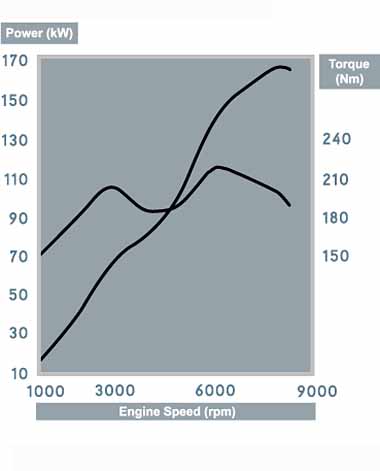

The FD2 Civic Type-R
This review really came about because of one of TOVA's staunch supporters as well as Honda freak Zane Loo. Zane is one of the many Malaysians who are lucky enough to be able to afford the FD2 Civic Type-R that Honda Malaysia put so much effort to introduce to the local (Malaysian) domestic line-up. It all started when Zane asked me whether I know anything about a rumour he's heard, that HONDATA has came out with a reflash for the FD2-R ECU. I contacted Doug MacMillon and within a few days, Zane received his HONDATA reflashed ECU ! Such was the superb efficiency that HONDATA works at.
A quick recap on the FD2 Civic Type R in the Malaysian domestic line-up. Honda Malaysia's extremely bold and fantastic move to offer the JDM-spec FD2 Civic Type-R as part of their Malaysian domestic line-up is of course now well known to Honda enthusiasts across the world. The units on sale here are true JDM-spec units, only slightly modified to conform to local road transport laws (like the mandatory fitting of a sound system for e.g.) All Malaysian market FD2-Rs comes in the NH-0 Championship Racing White colour.
 In standard form, the FD2R ECU features a rev-cut of 8,400rpm. And of course that legendary ~180kph
artificial speed limiter. At WOT, the ECU activates VTEC for the cam profile change at 5,700rpm. The stock
power/torque curve for the K20A-R engine as published by Honda features a very prominent 'hole' in
the mid-range between 3,000 to 6,000rpm, with the trough centered around 4,000 to 5,000rpm. This is
formed by a torque/power peak at just below 3,000rpm, followed by quite a significant drop in torque/power
until approx 5,700rpm where VTEC activates the wild-cams and torque/power picks up again. In the stock
torque/power chart, this torque/power pick-up is quite gradual, starting from 5,000rpm with the torque
peaking at around 6,000rpm, the max torque point. Honda published a gear vs speed chart showing how they
set the gear ratios to avoid this 'hole', with each gearshift at redline bringing the revs down to after
the 5,700rpm VTEC point. So in a straightforward WOT charge, according to Honda's design, every gearshift
at red-line will drops the revs right down to the starting edge of the wild-cams torque surge, thus
avoiding this mid-range hole.
In standard form, the FD2R ECU features a rev-cut of 8,400rpm. And of course that legendary ~180kph
artificial speed limiter. At WOT, the ECU activates VTEC for the cam profile change at 5,700rpm. The stock
power/torque curve for the K20A-R engine as published by Honda features a very prominent 'hole' in
the mid-range between 3,000 to 6,000rpm, with the trough centered around 4,000 to 5,000rpm. This is
formed by a torque/power peak at just below 3,000rpm, followed by quite a significant drop in torque/power
until approx 5,700rpm where VTEC activates the wild-cams and torque/power picks up again. In the stock
torque/power chart, this torque/power pick-up is quite gradual, starting from 5,000rpm with the torque
peaking at around 6,000rpm, the max torque point. Honda published a gear vs speed chart showing how they
set the gear ratios to avoid this 'hole', with each gearshift at redline bringing the revs down to after
the 5,700rpm VTEC point. So in a straightforward WOT charge, according to Honda's design, every gearshift
at red-line will drops the revs right down to the starting edge of the wild-cams torque surge, thus
avoiding this mid-range hole.
In real-life however, the activation of the wild-cams at 5,700rpm gives a very noticeable 'boost' once VTEC opens and this is reflected on the dyno as well. From our TOVA power check on a Dynojet, the dyno-chart shows that below 5,700rpm, torque was flat at 16.0 kg-m (approx 116 lb-ft) from 4,000rpm onwards. At 5,700rpm, VTEC opens and torque jumps suddenly by a rather big 4.0 kg-m to 20.0 kg-m (approx 145 lb-ft) within a narrow rpm band of 500rpm. So VTEC-on in the FD2-R is quite a dramatic affair with acceleration suddenly picking-up once the wild-cams cuts in. It also means that in the mid-range rpm band of 3,000 to 5,700rpm, the car can feel like its bogging down, as torque starts dropping from 3,000rpm and then stays flat at 16.0 kg-m until 5,700rpm.
While the sudden power increase at VTEC-on is just a little bit inconvenient, the ~180kph speed-cut is a lot more problematic. Such is the speed of the FD2R, that even on public roads, it is very easy to hit into this rev-cut in such simple situations as exiting an entry ramp and merging into a highway (i.e. not even an all out straight-line dash). Again it can prove frustrating on the race-track. In the Sepang International Circuit (SIC), the FD2R will hit the ~180kph speed limit in both the back and front straight, and way before the 200m braking marker. This means that we have to brake very very early, and not because the need to but before we are forced to.
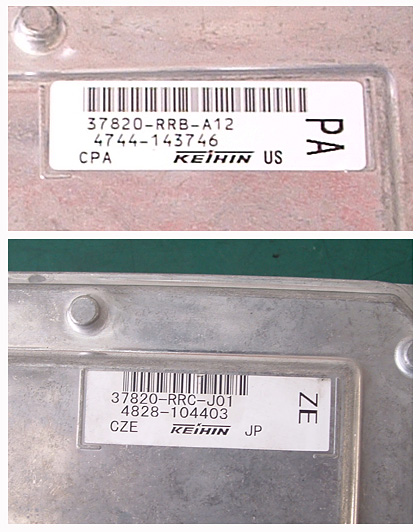
The HONDATA FD2-R ECU Reflash
Physically, the Hondata FD2-R ECU is a standard K-Series ECU re-programmed with HONDATA modified PGM-Fi code. The ECU that HONDATA shipped over has a sticker bearing the ECU code RRB and the word US on the right hand corner below. We believe this ECU was for the USDM Civic Si. When Zane's FD2-R ECU is taken out, we examined its sticker and found the code RRC with the word JP (Japan) below. So we believe the HONDATA ECU has been reflashed from an ECU originally meant for the USDM Civic Si. However, note that this detail is just for curiosity's sake. Which base K-series ECU is used for the reflash is of no consequence as the ECU internal is identical.
All the important stuff is of course 'on the inside', i.e. the PGM-Fi code that Hondata has modified. The details of this modification are as follows.
- - Speed limiter removed
- - 8,700 RPM rev limit
- - VTEC starts from 5,000 RPM, (lowered from 5,700)
- - VTEC window from 5,000-5,700
- - Cam angle advanced
- - Fueling altered for intakes and cat-backs
For VTEC, Hondata implemented a VTEC window from 5,000rpm to 5,700 rpm in their reflash. Below 5,000 rpm the K20A-R engine is always on the low cam. Above 5,700 rpm the K20A-R engine is always on the high cam. Between 5,000 rpm and 5700 rpm the K20a is on the low cam at part throttle switching to the high cam at full throttle.
Hondata has designed the reflash to work with both stock as well as mildly modified engines through modified fueling and also the VTC setting (adjusting the intake cam timing). So the reflash will work well with a stock Civic Type R and better if an intake or header is fitted. According to Hondata, the mods that matches the reflash will include
- Cat-backs that are less restrictive than stock. (They highlight that several are more restrictive.)
- A race header
- A combination of intake and race header
An important thing to note is that the HONDATA reflash has removed the Tatcham-1 ECU immobolizer function. This function is where the ECU exchanges code with the key when ignition is turned to the 'ON' position. So only when the correct key (which contains the correct code) is used will the ECU 'power-up'. This ECU-key based immobolizer function is one of the best and most secure car security system available. And it is not available with the HONDATA reflash.
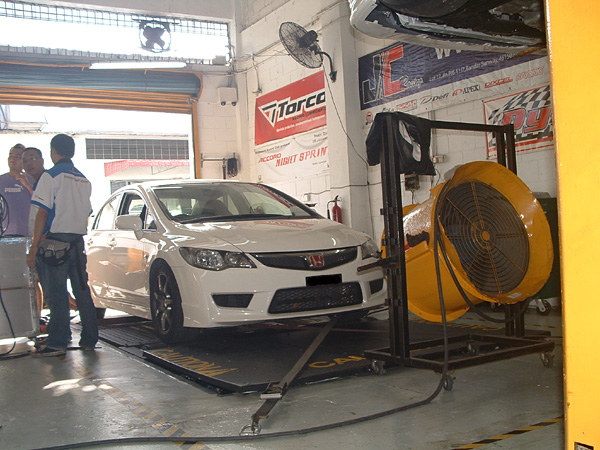
Dyno Power Check Result
Time for proof of the pudding. As per normal, JC Asia Motorsports very generously offered to sponsor our stock vs Hondata reflash dyno comparison. Owner Jackie actually owns an FD2 Civic Type-R himself and so just like us, he was very eager to see what (if any) improvements the Hondata reflashed ECU can deliver.
Although Zane had dyno'ed his FD2-R on the same dynojet machine a couple of months before (where he got around 195ps which was what was expected), we decided to do another baseline run this time. Zane says his car was totally unchanged between that earlier dyno and this new baseline. So logically, we should see the same power from the dyno-run. Or perhaps 1 or 2 ps more from running in of the engine - if Zane is lucky. As it turns out, it was very good that we decided to do the baseline dyno check because Zane's car delivered ~200ps from the baseline run, with a best run of ~202ps at the wheels on the dynojet !! This was a massive 5-7ps more than what the car/engine delivered just a short couple of months ago. When I looked at Zane suspiciously, he reiterated that he did not do any change to the car at all and that the car was exactly the same then as it was 2 months earlier (including the non-stock 17" wheels). The only difference was an extra 18,000km of mileage running-in of the engine. Accumulated mileage was below 10,000km two months ago, but very high daily usage means it's over close to 30,000km 2 short months later. Can just running in of the engine produce so much improvement ? It would seem so from this baseline run !
After that initial shock of a much higher than expected baseline result, we proceeded to replace the stock ECU with the Hondata reflashed unit. The K-Series ECU is located in the engine bay, next to the battery. Removal entailed unplugging the wiring harness sockets from the ECU and unscrewing the unit, complete with its resin protective cover. Once out, the resin cover is taken out (it is just slotted into the ECU) and we put it on the Hondata unit, then install the ECU back into its location beside the battery.
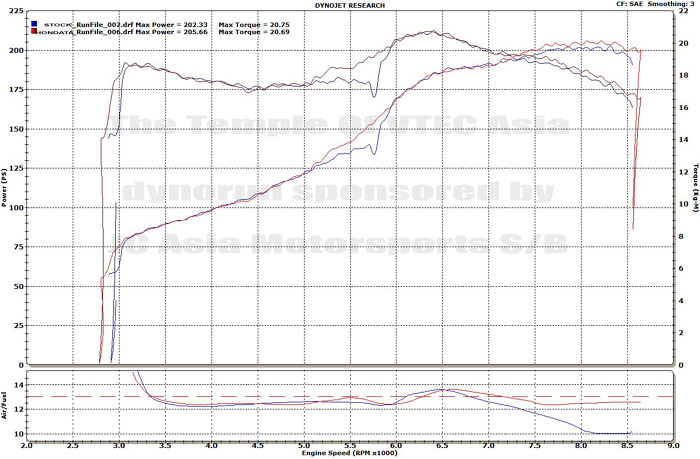 |
|
|
Now the eagerly awaited result of the 'after' dyno-run. After letting the engine settle down with some prelimary runs, the dyno-result of the FD2-R with the Hondata reflashed ECU came out to be a very nice ~206ps at the wheels ! From the dyno-chart, this 4ps increase in max power was through a tweaking of the AF for the high-rpm band (though we do not know if ignition timing has been tweaked or not) - a leaning of the AF to bring it closer to the 13:1 rule-of-thumb (for maximum power deliver on a Honda NA engine) from ~6,500rpm onwards till the rev-cut. The actual AF the engine runs at is still slightly rich at approximately 12.5:1 though I am not sure if this is because 12.5 is the best AF for max power delivery or because Hondata still wants to factor in a degree of safety for high-rpm operations (running slightly rich to avoid detonation). A Mugen race-ECU for the FD2-R for e.g. runs the engine at exactly 13:1 AF through the whole rpm band but it of course does not caters so much for reliability as HONDATA needs to, PLUS it is programmed to run with a heavily modified Mugen K20A-R engine. Power also increased at the top-end, from 7,000rpm onwards and the power curve is a lot flatter right till the rev-cut instead of clearly dropping off after around 8,000rpm. All these with a completely stock engine with just some fueling and possibly ignition timing optimization !
The other (very) important improvement from the HONDATA reflash is the flattening of the power/torque curve, or rather the removal of the mid-band 'hole' or dip in the power/torque chart in the 3,000rpm to 6,000rpm band. The power delivery has been smoothened considerably, instead of tapering off after 5,000rpm and then suddenly jumping up at 5,700rpm when VTEC activates the wild cams. The power increase in this region can be quite considerable - between 15 to 20ps at certain points ! The VTEC transition power 'surge' is of course dulled with this improvement so 'VTEC-on' is no longer as dramatic as the stock ECU but the car pulls a lot more over this rpm band now. The tweaking of the fueling (and ignition timing) is clearly seen with a general leaning of the AF in this rpm band, jumping to almost 13:1 at 5,500rpm.
As for the removal of the 180+kph speed-cut, HONDATA is one of the very few proper removal. HONDATA modifies the actual PGM-Fi code to remove this speed-cut, unlike J's Racing's FD2R ECU for e.g. where it removes the speed-cut by 'cheating' the ECU - by modifying the VSS (Vehicle Speed Sensor) signal, replacing with a signal of constant 180kph signal once vehicle speed exceeds 180kph. So the ECU thinks the car is still going at only 180kph eventhough it has already far exceeded this speed. This means the speedo readout on the dash shows speed fixed at 180kph no matter how fast the car is going. With the HONDATA ECU, the speed increases accordingly, and Zane have been updating me regularly about his 'adventures' in top-speeds, his current record being 259kph.
The increase of the rev-cut from 8,400rpm to 8,700rpm is a 300rpm increase. On the dash, this will see the tacho hitting nearly 9,000rpm as the tacho over-reads by quite a bit. The main benefit from this increase in rev-cut is in the so-called 'standing-start' acceleration runs - the stock 8,400rpm rev-cut limits top-speed in 2nd gear to 95kph or just below 60mph. This means even the 0-60mph run requires 2 gear-changes (1st to 2nd, 2nd to 3rd). A 8,700rpm rev-cut still means 2 gear-changes for 0-100kph but as top-speed in 2nd is now 98-99kph, it means only the 1st to 2nd gear-change is required for the 0-60mph drag, which will be greatly beneficial to the timing for this run. Zane has agreed to let me do some acceleration tests on his FD2-R with my AF22 and I hope to get that done in the near future.
Conclusion
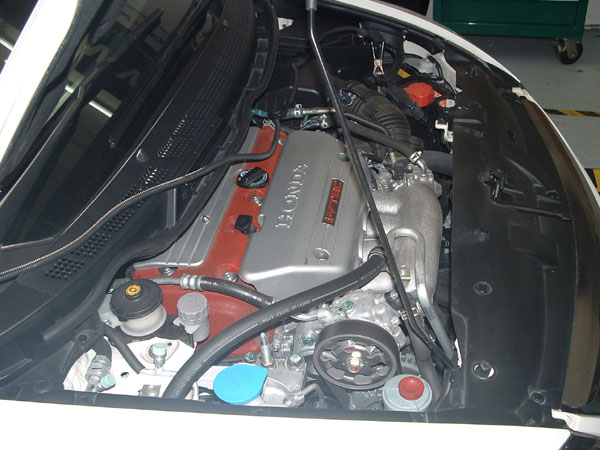 How much can ECU tuning do to a completely stock FD2 Civic Type-R ? Plenty, as we can clearly see
from the HONDATA reflash. From an actual FD2-R owner who did adopted the HONDATA reflash, I can confirm
that he is extremely happy with the upgrade. The most significant one is the removal of the artificial
180+kph speed cut, done properly inside the PGM-Fi codes, and with the actual vehicle speed
properly showing on the digital speedometer read-out. As a bonus, the HONDATA reflash also offers more
power and a much, much improved mid-range.
How much can ECU tuning do to a completely stock FD2 Civic Type-R ? Plenty, as we can clearly see
from the HONDATA reflash. From an actual FD2-R owner who did adopted the HONDATA reflash, I can confirm
that he is extremely happy with the upgrade. The most significant one is the removal of the artificial
180+kph speed cut, done properly inside the PGM-Fi codes, and with the actual vehicle speed
properly showing on the digital speedometer read-out. As a bonus, the HONDATA reflash also offers more
power and a much, much improved mid-range.
The retail price for the HONDATA FD2-R reflash depends on the option adopted - shipping the original ECU to them for reflash is cheaper then buying a complete HONDATA ECU. But for Malaysian and possibly other FD2-R owners, the complete HONDATA ECU is what I would recommend. This is because of the ECU immobolizer feature that has been removed with the HONDATA reflash so for normal daily use, perhaps the original stock ECU should be retained and the HONDATA ECU put in for track-days.
Regardless of which method is chosen however, the most important conclusion is that the HONDATA FD2R ECU reflash is highly recommended indeed. For more details of this reflash, visit the HONDATA website.
September 2008
© Temple of VTEC Asia